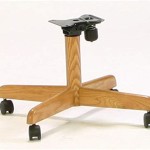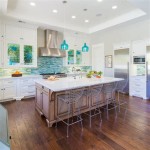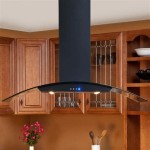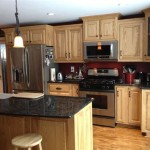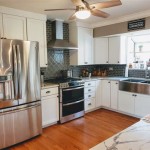Kitchen Island Counter Design: A Comprehensive Guide
The kitchen island has evolved from a simple workspace to a central hub in modern homes. It serves multiple functions, acting as a preparation area, dining space, storage unit, and social gathering point. Central to the island's functionality and aesthetic is the countertop, which plays a crucial role in both its utility and visual appeal. Choosing the right countertop material, size, and design details is essential for creating a kitchen island that meets specific needs and complements the overall kitchen style.
This article delves into various aspects of kitchen island counter design, exploring different materials, design considerations, and practical tips for selecting the perfect countertop. It provides a comprehensive overview to assist homeowners and designers in making informed decisions regarding this critical kitchen element.
Material Selection: Balancing Aesthetics and Functionality
The choice of countertop material is paramount, impacting the island’s durability, maintenance requirements, and overall appearance. Numerous materials are available, each with its own set of advantages and disadvantages. Factors to consider include resistance to scratches, heat, and stains, as well as the material's porosity, cost, and aesthetic characteristics.
Granite is a popular choice known for its durability and heat resistance. Its natural variations in color and pattern create a unique and elegant look. However, granite requires sealing to prevent staining and can be more expensive than other options. Its weight also necessitates strong support structures.
Quartz (engineered stone) offers a consistent appearance and is non-porous, making it resistant to stains and bacteria. It is available in a wide range of colors and patterns, including options that mimic natural stone. Quartz is generally more affordable than high-end granite and requires less maintenance. However, it may not be as heat resistant as granite and can be susceptible to damage from extreme temperatures.
Marble is prized for its luxurious appearance and unique veining. It is a softer stone than granite or quartz, making it more prone to scratches and etching from acidic substances. Marble requires more diligent maintenance and sealing to prevent staining. It is often used in kitchens where a high-end aesthetic is prioritized over absolute durability.
Butcher Block provides a warm and natural aesthetic. It is a durable and renewable surface, but it requires regular oiling to prevent drying and cracking. Butcher block is susceptible to water damage and can harbor bacteria if not properly maintained. It is often used as a focal point on a portion of the island, such as a chopping block area.
Concrete offers a modern and industrial look. It can be custom-colored and shaped to fit specific design needs. Concrete is durable but can be porous and prone to staining if not properly sealed. Cracking can also occur over time. It can be more expensive than other options due to the custom fabrication process.
Solid Surface materials, such as Corian, are non-porous and seamless, making them hygienic and easy to clean. They are available in a wide range of colors and patterns and can be thermoformed into custom shapes. Solid surface countertops are less heat resistant than granite or quartz and can be susceptible to scratches.
Laminate is a cost-effective option that comes in a vast array of colors and patterns. It is easy to clean but is not as durable as other materials and can be susceptible to scratches and heat damage. Laminate countertops are a good choice for budget-conscious homeowners.
Stainless Steel provides a sleek and modern look and is highly durable and hygienic. It is resistant to heat and stains but can be susceptible to scratches and dents. Stainless steel countertops are a popular choice for professional kitchens.
Considerations beyond material properties include the overall kitchen design. A modern kitchen might benefit from quartz or stainless steel, while a traditional kitchen might be complemented by granite or butcher block. The chosen material should also harmonize with the cabinetry, flooring, and backsplash.
Design Elements: Size, Shape, and Overhang
The design of the kitchen island countertop goes beyond simply choosing a material. The size, shape, and overhang are critical factors that influence functionality and aesthetics. These elements should be carefully considered in relation to the overall kitchen layout and the intended use of the island.
Size: The size of the countertop should be proportional to the size of the island and the overall kitchen space. A too-small countertop can look awkward and limit functionality, while an overly large countertop can overwhelm the space and impede traffic flow. The depth of the countertop should be sufficient for comfortable food preparation, dining, or other activities. A minimum depth of 24 inches is generally recommended for a preparation surface. Longer islands may require seams in the countertop material, which should be strategically placed to minimize visibility and maintain structural integrity.
Shape: The shape of the countertop can significantly impact the kitchen's aesthetic and functionality. Rectangular countertops are the most common and provide ample workspace. Rounded or curved countertops can soften the look of the kitchen and create a more inviting atmosphere. L-shaped or U-shaped countertops can provide additional workspace and seating. The shape should be chosen based on the style of the kitchen and the desired functionality of the island.
Overhang: An overhang is the portion of the countertop that extends beyond the base cabinets. Overhangs are essential for creating comfortable seating at the island. A minimum overhang of 12 inches is recommended for counter-height seating, while a minimum overhang of 15 inches is recommended for bar-height seating. The overhang should be supported by brackets or corbels to prevent sagging or breakage. The shape of the overhang can also enhance the design of the island. A waterfall edge, where the countertop material extends down the sides of the island, can create a dramatic and modern look.
Furthermore, consider the placement of appliances within the island, such as a cooktop or sink. Adequate space should be allocated around these appliances for safe and efficient use. The placement of electrical outlets and plumbing should also be carefully planned to ensure functionality and compliance with building codes.
Practical Considerations: Maintenance and Budget
Beyond aesthetics and design, practical considerations such as maintenance requirements and budget constraints play a significant role in selecting the ideal kitchen island countertop. Understanding the long-term costs associated with different materials is crucial for making an informed decision.
Maintenance: Different countertop materials require varying levels of maintenance. Granite and marble require regular sealing to prevent staining, while quartz and solid surface materials are relatively low-maintenance. Butcher block requires regular oiling to prevent drying and cracking. Laminate is easy to clean but can be damaged by heat and scratches. Stainless steel requires regular cleaning to prevent fingerprints and smudges. The amount of time and effort required for maintenance should be considered when selecting a countertop material.
Budget: The cost of countertop materials can vary significantly. Laminate is the most affordable option, while marble and high-end granite are the most expensive. Quartz and solid surface materials fall in the mid-range. The cost of installation should also be considered. Intricate designs and custom shapes may require more labor and increase the overall cost. Setting a realistic budget and exploring different options within that budget is essential.
Durability: Consider the level of activity in the kitchen and choose a countertop material that can withstand daily use. For busy families with children, durable and scratch-resistant materials like quartz or granite are recommended. For kitchens that are primarily used for entertaining, materials like marble may be a suitable choice, even with their higher maintenance requirements. Understanding the potential wear and tear on the countertop will help in selecting a material that will last for years to come.
It is also beneficial to research suppliers and installers to ensure competitive pricing and quality workmanship. Obtain multiple quotes and compare prices before making a final decision. Consider visiting showrooms to see different materials in person and get a feel for their texture and appearance. Consulting with a kitchen designer or contractor can provide valuable insights and guidance throughout the selection process.
By carefully considering material options, design elements, and practical considerations, homeowners can create a kitchen island countertop that is both beautiful and functional, enhancing the overall kitchen experience for years to come. A well-designed kitchen island can become the heart of the home, providing a gathering place for family and friends and a functional space for preparing meals and creating memories.

90 Modern Kitchen Island Ideas To Transform Your Home In 2025

47 Best Kitchen Island Ideas Stylish Unique Design Tips

When It Comes To Countertop Design Raised Bars Are A Thing Of The Past

Kitchen Island Countertop Options Academy Marble Ny Ct

Guide To Kitchen Islands Everything You Need Know

Crafting The Ideal Kitchen Island Layouts Tips And Examples

Millstone Wooden Kitchen Island Counter Height Table

10 Kitchen Island Features Pros Always Recommend

Kitchen Island Ideas Sizing Seating Appliances Much More

Creating The Ultimate Modern Kitchen Top Design Gemini Worktops
Related Posts


